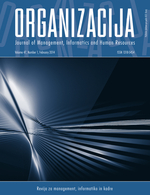An Overview of Models for Assessment of Organization Virtuality
Abstract
A virtual organization is a network of legally independent organizations and/or individuals that produce products and/or services based on a common business understanding. This new organization structure is posited as radical departure from the traditional, hierarchic, bureaucratic and co-located mode of organizing that dominated the twentieth century. In contrast, the characteristics of the new, virtual organization forms are seen to be dynamic, networked, distributed, digital, flexible, collaborative and innovative. The challenge, however, is to determine which organization as a subject employs virtual form and which not. The answer to this question is decidedly complex as most organizations have forms that are somewhere in between; therefore, it is usually only possible to determine how virtual one organization is on certain aspects. In the other words: what is the level of its virtuality? Several models for the assessment of organization virtuality have been developed by many different authors. The purpose of this paper is to investigate and present all the published models of virtual organization that are publicly available in the world literature. The strengths and weaknesses of all models found are presented, together with their mutual relations.
Refbacks
- There are currently no refbacks.

